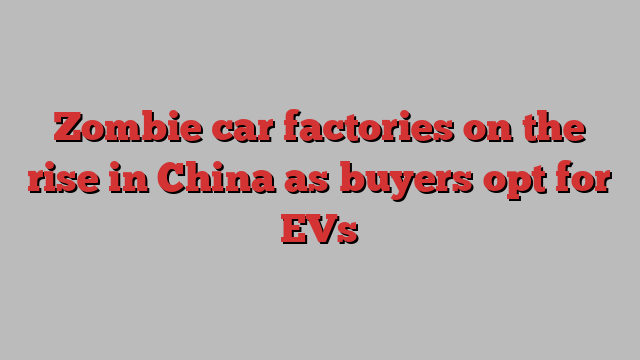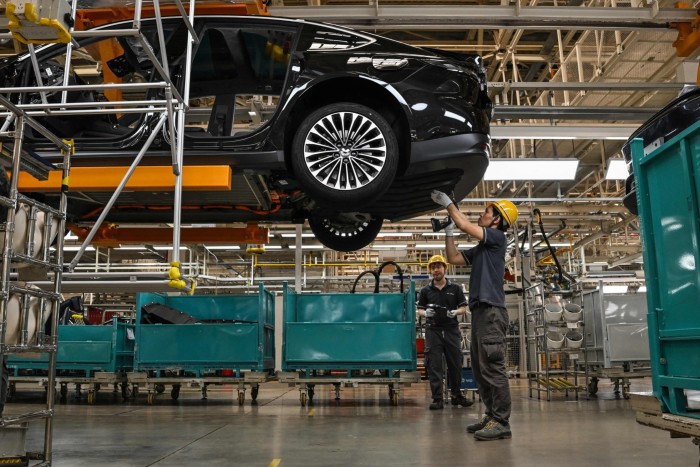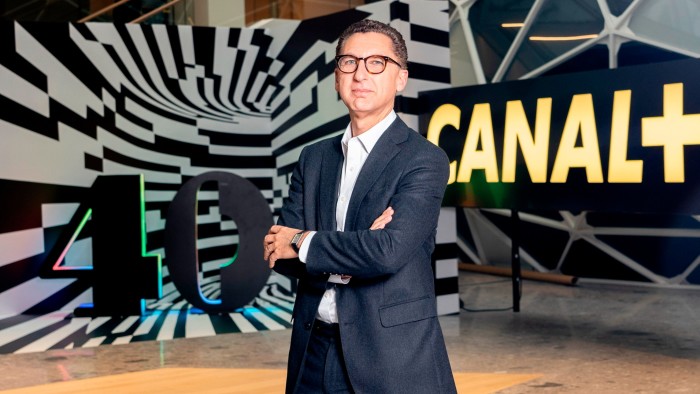
Zombie car factories on the rise in China as buyers opt for EVs
In 2017, Hyundai invested $1.15bn in a new factory in Chongqing, southwestern China, with the goal of reaching an annual output of 300,000 internal combustion engine cars.
But six years later, the rapid switch by Chinese consumers to electric vehicles has stalled sales, forcing the automaker to sell the factory in December for less than a quarter of the investment value.
“The Chongqing plant continued to be in the red and China’s auto market is grappling with oversupply,” said Lee Hang-koo at the Jeonbuk Institute of Automotive Convergence Technology, a South Korean research group. “No one was willing to buy the plant at a high price.”
That plant is one of the hundreds of zombie factories that analysts are predicting over the next decade in the Chinese auto market, the world’s biggest across sales, production and, since last year, exports. In 2023, China produced 17.7mn internal combustion engine cars, a 37 per cent fall from its prior peak in 2017, according to data from Automobility, a Shanghai consultancy.
Bill Russo, the former head of Chrysler in China and founder of advisory firm Automobility, said that the “precipitous decline” of internal combustion engine car sales means as much as half of the industry’s installed capacity — around 25mn units of 50mn units annual capacity — is not being used.
While some older factories will be repurposed for plug-in hybrids or pure battery electric vehicles, others will never produce another car, posing a problem for both foreign and Chinese companies.
Many auto groups in China, Russo said, ultimately face two choices: “Leave the factory mothballed or crank out some volume and send it to Russia, send it to Mexico.”
Hyundai’s exit from Chongqing comes as combined car sales in China by Hyundai and its Kia affiliate fell to 310,000 last year from nearly 1.8mn in 2016, as a result of free-falling sales of internal combustion engine cars. Hyundai, which makes cars in China as part of a joint venture with state-backed BAIC Motor, declined to comment on its China business.

An intense price war across the Chinese auto sector is only heaping more pressure on legacy automakers, including top foreign players Toyota, Volkswagen and GM, which have been slower to release popular low-cost EV and hybrid models and are quickly losing market share to companies such as BYD and Tesla.
Until recently, foreign auto groups could only enter the Chinese market as a joint venture with a local partner. Of 16 joint ventures between Chinese and foreign carmakers, only five had a capacity utilisation rate higher than 50 per cent while eight were below 30 per cent, according to a report by Chinese media outlet Yicai Global.
In response to the worsening domestic market situation, Chinese companies have been ramping up exports of cheap petrol-powered cars to Russia, a market that many international carmakers have quit in the wake of that country’s full-scale invasion of Ukraine.
Yet analysts question whether those sales deliver meaningful profits to the Chinese groups, for how long they can continue, or if other developing markets can help soak up Chinese non-EV exports.
Foreign brands, too, are increasingly trying to export more from their Chinese factories. But, experts say, in doing this companies risk undercutting their own factories in other markets.

VW, the largest foreign carmaker by sales operating in China, declined to provide excess capacity figures in the country but said the market for petrol-powered cars was still lucrative.
Growth, VW believes, will mostly come from the hundreds of smaller Chinese cities that usually have a population of 3mn or below. That is in part because car ownership in the bigger, more developed cities is high and restrictions on buying new petrol-powered cars are already in place. But another key factor is the lack of charging infrastructure in poorer cities, which has frustrated EV industry growth.
“The number of cars in China is still very low. While the average here is just 185 vehicles per 1,000 inhabitants, there are almost 800 vehicles per 1,000 inhabitants in the USA and around 580 in Germany,” said VW.
VW last year announced €5bn worth of investments in China as it targets ramping up production of EVs. It has started converting some factory lines in China to produce EVs. And the group will also work to “gradually hybridise the internal combustion engine models and thereby convert them into an electrified new energy vehicle fleet,” the company added.
But VW is an outlier in deciding to double down on the Chinese market — spending by most other foreign automakers in China has ground to a halt.
Industry executives say that the biggest pressure on all legacy automakers in China stems from the rise of new EV factories, which take a radically different approach to car manufacturing.
In Hefei, west of Shanghai, a factory owned by Nio demonstrates this challenge. The factory, opened in late 2022, is designed around founder William Li’s bet that EV customers will increasingly want cars with customised features, rather than a mass market product from a dealer.

The factory offers different configurations — both physical design and software features — among its eight different Nio models. Cars can be delivered in China around three weeks after they are ordered, or 90 days to customers in Europe.
Nio’s Hefei factory will soon have the capacity to produce 300,000 vehicles annually — the target for Hyundai’s Chongqing factory less than 10 years ago.
John Jiang, the Nio factory manager who previously worked with GM in China, says all carmakers in China are in a fight for survival: “not every brand can succeed in the end”.
Additional reporting by Song Jung-a in Seoul and Gloria Li in Hong Kong






